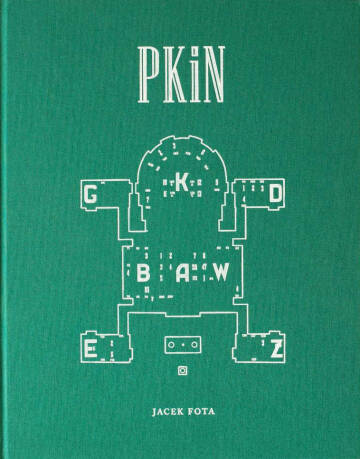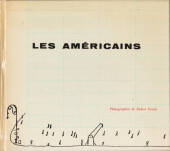Pkin (signed)
by Jacek Fota
Photographs: Jacek Fota
Text: Agnieszka Rasmus-Zgorzelska
Publisher: Fundacja Centrum Architektury
112 pages
Pictures: 70
Year: 2015
ISBN: 978-83-937716-6-0
Price: 55 €
Comments: Hand made book, hardcover, 23.5 x 29.6 cm, first edition: 400 + 30 copies (only 150 for sale).
The Palace of Culture and Science in Warsaw – less and less a symbol of Stalinist domination, more and more an icon of the city. It evokes strong emotions all the while remaining largely unexplored, and as such a tad alien. At the time of planning, in 1952, the monumental structure was intended to transform the scale of Warsaw cityscape. The skyscrapers that now cluster to the west of the Palace compete with the building. Nonetheless, due to vast and empty parade grounds surrounding it, the Palace towers over Warsaw thus far unthreatened. After 1989 its demolition was repeatedly debated, albeit never seriously considered. In 2007 the building was finally listed.
The Palace was erected in the years 1952-55 by 3,500 Soviet builders on the bombed 19th century quarters in the city centre. The bulk of construction costs was covered by the Soviet government. Lev Rudnev, the Palace's chief designer, modelled the project on the Stalinist “Seven Sisters” skyscrapers in Moscow, themselves inspired by American architecture.
More books by Jacek Fota
more books tagged »soviet« | >> see all
-
Soviet Bus Stops Volume II
by Christopher Herwig
sold out -
11.41 (signed)
by Michal Luczak
Euro 38 -
Wonderland: A Fairytale of a Soviet Monolith (signed)
by Jason Eskenazi
Euro 65 -
Soviet Passport (signed)
by Tatiana Fiodorova
Euro 60 -
Soviet Bus Stops
by Christopher Herwig
sold out -
Amateurs & Lovers
by Nikolay Bakharev
sold out
more books tagged »architecture« | >> see all
-
Sunless
by Tiane Doan na Champassak
sold out -
Forget Your Past (signed)
by Nikola Mihov
sold out -
Itoshima
by Juliane Eirich
sold out -
720 (two times around) (signed - last copy)
by Andrew Phelps
sold out -
One Picture Book 89: Corridors (signed + print)
by Steve Kahn
Euro 45 36.00 -
DEEPER SHADES #03 PARIS (signed)
by Andreas H. Bitesnich
Euro 70
more books tagged »Warsaw« | >> see all
-
The First March of Gentlemen (book + print)
by Rafal Milach
sold out -
The First March of Gentlemen (signed - last copy)
by Rafal Milach
sold out
more books tagged »post-Soviet« | >> see all
-
PROMISING WATERS (signed)
by Mila Tshaieva
sold out -
Bertien van Manen in Moldova (signed)
by Bertien van Manen
sold out -
An Atlas of War and Tourism in the Caucasus (signed)
by Rob Hornstra
sold out -
Lviv – God’s Will
by Viacheslav Poliakov
Euro 46 -
Venten på i går - Auf gestern warten (signed)
by Krass Clement
Euro 125 -
Not Natasha
by Dana Popa
sold out
more books tagged »interior« | >> see all
-
Timekeepers (signed)
by Matjaž Tančič
sold out -
Kitchen Stories from the Balkans (signed - last copies)
by Eugenia Maximova
sold out -
Ik ben jou (signed)
by Milou Abel
sold out -
Places of Worship
by Andreas Duscha
sold out -
Hong Kong Inside Outside
by Michael Wolf
sold out -
Just the Two of Us (signed - single copy)
by Klaus Pichler
Euro 250
more books tagged »Polish« | >> see all
-
American Dream (signed)
by Agnieszka Rayss
Euro 40 -
In the Car with R
by Rafal Milach
sold out -
IS(not) (signed - last copies)
by Sputnik Photos
Euro 150 -
Distant Place
by Sputnik Photos
Euro 75 -
Post-war Stories
by Claudia Heinermann / Michael Iwanowski / Indre Serpytyte
sold out -
The Winners (signed)
by Rafal Milach
sold out
Random selection from the Virtual bookshelf josefchladek.com
Pkin (signed)
by Jacek Fota
Photographs: Jacek Fota
Text: Agnieszka Rasmus-Zgorzelska
Publisher: Fundacja Centrum Architektury
112 pages
Pictures: 70
Year: 2015
ISBN: 978-83-937716-6-0
Price: 55 €
Comments: Hand made book, hardcover, 23.5 x 29.6 cm, first edition: 400 + 30 copies (only 150 for sale).
The Palace of Culture and Science in Warsaw – less and less a symbol of Stalinist domination, more and more an icon of the city. It evokes strong emotions all the while remaining largely unexplored, and as such a tad alien. At the time of planning, in 1952, the monumental structure was intended to transform the scale of Warsaw cityscape. The skyscrapers that now cluster to the west of the Palace compete with the building. Nonetheless, due to vast and empty parade grounds surrounding it, the Palace towers over Warsaw thus far unthreatened. After 1989 its demolition was repeatedly debated, albeit never seriously considered. In 2007 the building was finally listed.
The Palace was erected in the years 1952-55 by 3,500 Soviet builders on the bombed 19th century quarters in the city centre. The bulk of construction costs was covered by the Soviet government. Lev Rudnev, the Palace's chief designer, modelled the project on the Stalinist “Seven Sisters” skyscrapers in Moscow, themselves inspired by American architecture.
More books by Jacek Fota
more books tagged »soviet« | >> see all
-
Soviet Bus Stops Volume II
by Christopher Herwig
sold out -
11.41 (signed)
by Michal Luczak
Euro 38 -
Wonderland: A Fairytale of a Soviet Monolith (signed)
by Jason Eskenazi
Euro 65 -
Soviet Passport (signed)
by Tatiana Fiodorova
Euro 60 -
Soviet Bus Stops
by Christopher Herwig
sold out -
Amateurs & Lovers
by Nikolay Bakharev
sold out
more books tagged »architecture« | >> see all
-
Sunless
by Tiane Doan na Champassak
sold out -
Forget Your Past (signed)
by Nikola Mihov
sold out -
Itoshima
by Juliane Eirich
sold out -
720 (two times around) (signed - last copy)
by Andrew Phelps
sold out -
One Picture Book 89: Corridors (signed + print)
by Steve Kahn
Euro 45 36.00 -
DEEPER SHADES #03 PARIS (signed)
by Andreas H. Bitesnich
Euro 70
more books tagged »Warsaw« | >> see all
-
The First March of Gentlemen (book + print)
by Rafal Milach
sold out -
The First March of Gentlemen (signed - last copy)
by Rafal Milach
sold out
more books tagged »post-Soviet« | >> see all
-
PROMISING WATERS (signed)
by Mila Tshaieva
sold out -
Bertien van Manen in Moldova (signed)
by Bertien van Manen
sold out -
An Atlas of War and Tourism in the Caucasus (signed)
by Rob Hornstra
sold out -
Lviv – God’s Will
by Viacheslav Poliakov
Euro 46 -
Venten på i går - Auf gestern warten (signed)
by Krass Clement
Euro 125 -
Not Natasha
by Dana Popa
sold out
more books tagged »interior« | >> see all
-
Timekeepers (signed)
by Matjaž Tančič
sold out -
Kitchen Stories from the Balkans (signed - last copies)
by Eugenia Maximova
sold out -
Ik ben jou (signed)
by Milou Abel
sold out -
Places of Worship
by Andreas Duscha
sold out -
Hong Kong Inside Outside
by Michael Wolf
sold out -
Just the Two of Us (signed - single copy)
by Klaus Pichler
Euro 250
more books tagged »Polish« | >> see all
-
American Dream (signed)
by Agnieszka Rayss
Euro 40 -
In the Car with R
by Rafal Milach
sold out -
IS(not) (signed - last copies)
by Sputnik Photos
Euro 150 -
Distant Place
by Sputnik Photos
Euro 75 -
Post-war Stories
by Claudia Heinermann / Michael Iwanowski / Indre Serpytyte
sold out -
The Winners (signed)
by Rafal Milach
sold out
Random selection from the Virtual bookshelf josefchladek.com
Pkin (signed)
by Jacek Fota
Photographs: Jacek Fota
Text: Agnieszka Rasmus-Zgorzelska
Publisher: Fundacja Centrum Architektury
112 pages
Pictures: 70
Year: 2015
ISBN: 978-83-937716-6-0
Price: 55 €
Comments: Hand made book, hardcover, 23.5 x 29.6 cm, first edition: 400 + 30 copies (only 150 for sale).
The Palace of Culture and Science in Warsaw – less and less a symbol of Stalinist domination, more and more an icon of the city. It evokes strong emotions all the while remaining largely unexplored, and as such a tad alien. At the time of planning, in 1952, the monumental structure was intended to transform the scale of Warsaw cityscape. The skyscrapers that now cluster to the west of the Palace compete with the building. Nonetheless, due to vast and empty parade grounds surrounding it, the Palace towers over Warsaw thus far unthreatened. After 1989 its demolition was repeatedly debated, albeit never seriously considered. In 2007 the building was finally listed.
The Palace was erected in the years 1952-55 by 3,500 Soviet builders on the bombed 19th century quarters in the city centre. The bulk of construction costs was covered by the Soviet government. Lev Rudnev, the Palace's chief designer, modelled the project on the Stalinist “Seven Sisters” skyscrapers in Moscow, themselves inspired by American architecture.
More books by Jacek Fota
more books tagged »soviet« | >> see all
-
Soviet Bus Stops Volume II
by Christopher Herwig
sold out -
11.41 (signed)
by Michal Luczak
Euro 38 -
Wonderland: A Fairytale of a Soviet Monolith (signed)
by Jason Eskenazi
Euro 65 -
Soviet Passport (signed)
by Tatiana Fiodorova
Euro 60 -
Soviet Bus Stops
by Christopher Herwig
sold out -
Amateurs & Lovers
by Nikolay Bakharev
sold out
more books tagged »architecture« | >> see all
-
Sunless
by Tiane Doan na Champassak
sold out -
Forget Your Past (signed)
by Nikola Mihov
sold out -
Itoshima
by Juliane Eirich
sold out -
720 (two times around) (signed - last copy)
by Andrew Phelps
sold out -
One Picture Book 89: Corridors (signed + print)
by Steve Kahn
Euro 45 36.00 -
DEEPER SHADES #03 PARIS (signed)
by Andreas H. Bitesnich
Euro 70
more books tagged »Warsaw« | >> see all
-
The First March of Gentlemen (book + print)
by Rafal Milach
sold out -
The First March of Gentlemen (signed - last copy)
by Rafal Milach
sold out
more books tagged »post-Soviet« | >> see all
-
PROMISING WATERS (signed)
by Mila Tshaieva
sold out -
Bertien van Manen in Moldova (signed)
by Bertien van Manen
sold out -
An Atlas of War and Tourism in the Caucasus (signed)
by Rob Hornstra
sold out -
Lviv – God’s Will
by Viacheslav Poliakov
Euro 46 -
Venten på i går - Auf gestern warten (signed)
by Krass Clement
Euro 125 -
Not Natasha
by Dana Popa
sold out
more books tagged »interior« | >> see all
-
Timekeepers (signed)
by Matjaž Tančič
sold out -
Kitchen Stories from the Balkans (signed - last copies)
by Eugenia Maximova
sold out -
Ik ben jou (signed)
by Milou Abel
sold out -
Places of Worship
by Andreas Duscha
sold out -
Hong Kong Inside Outside
by Michael Wolf
sold out -
Just the Two of Us (signed - single copy)
by Klaus Pichler
Euro 250
more books tagged »Polish« | >> see all
-
American Dream (signed)
by Agnieszka Rayss
Euro 40 -
In the Car with R
by Rafal Milach
sold out -
IS(not) (signed - last copies)
by Sputnik Photos
Euro 150 -
Distant Place
by Sputnik Photos
Euro 75 -
Post-war Stories
by Claudia Heinermann / Michael Iwanowski / Indre Serpytyte
sold out -
The Winners (signed)
by Rafal Milach
sold out
Random selection from the Virtual bookshelf josefchladek.com













































_(深瀬_昌久_遊戯_映像の現代4);jpg?c=fcb3804a689cc8a82868e2a5b48119cf)
_(荒木経惟_ゼロックス写真帳_#2);jpg?c=bdba23fd82bb23d331b7db92a836c403)






;jpg?c=30680946c79018a3c23d7b3ea13e8de6)





;jpg?c=23e41b858019d2c3573bb4fda8f98a37)